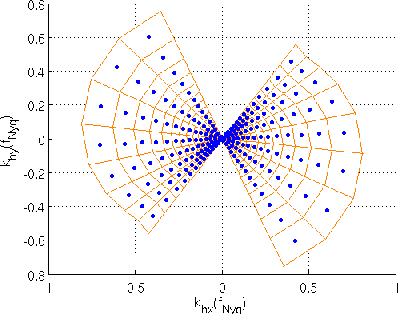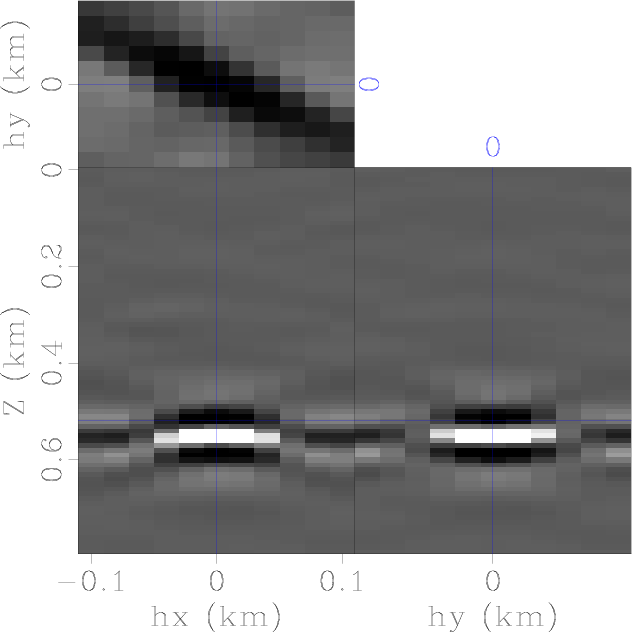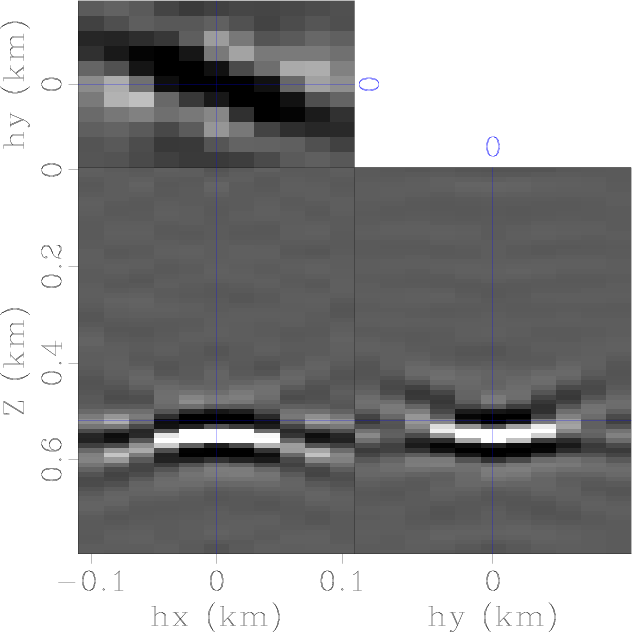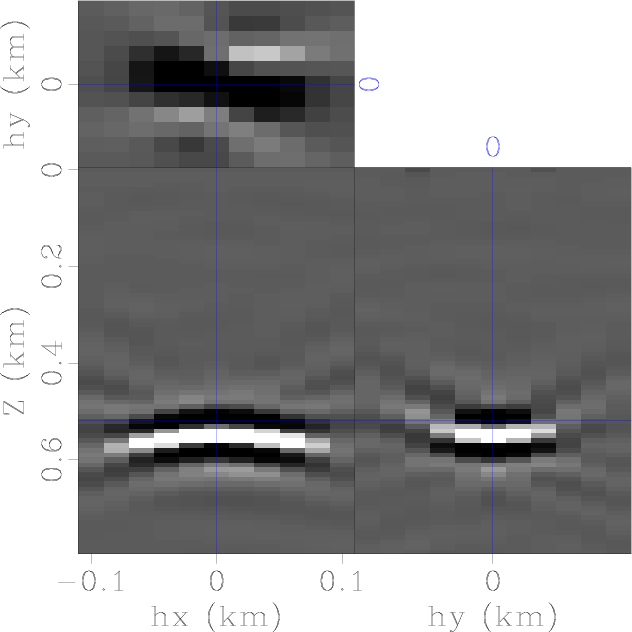|
|
|
|
Residual moveout-based wave-equation migration velocity analysis in 3-D |
 .
.
 ,
,

 based on the following relations (Tisserant and Biondi, 2003):
based on the following relations (Tisserant and Biondi, 2003):
 .
.


|
|---|
|
a2omapping0,a2omapping1
Figure 4. Graphical illustration of the mapping from the  plane to the
plane to the
 plane. Each dot in (a) maps to a corresponding dot in (b); similarly, each quadrilateral patch in (a) maps to a corresponding patch in (b).
plane. Each dot in (a) maps to a corresponding dot in (b); similarly, each quadrilateral patch in (a) maps to a corresponding patch in (b).
|
|
|
The mapping between
 and
and  is highly irregular (Biondi, 2003). Figure 4 shows the mapping from a regularly sampled
is highly irregular (Biondi, 2003). Figure 4 shows the mapping from a regularly sampled
 mesh to the
mesh to the
 domain given fixed
domain given fixed
 and
and  (assume the Nyquist wave number is 1).
We can see the mapping brings distortion, and the density of the samples on
(assume the Nyquist wave number is 1).
We can see the mapping brings distortion, and the density of the samples on
 becomes non-uniform. A proper interpolation scheme is very important to reduce the artifacts caused by such irregularity.
This issue becomes more serious for the backward transform (angle to offset), because the azimuth angle
becomes non-uniform. A proper interpolation scheme is very important to reduce the artifacts caused by such irregularity.
This issue becomes more serious for the backward transform (angle to offset), because the azimuth angle  is usually not sufficiently sampled; simply placing all available samples on the
is usually not sufficiently sampled; simply placing all available samples on the
 plane onto their mapped locations on
plane onto their mapped locations on
 plane would leave many holes unfilled.
On the other hand, under mapping relation 21, it is easy to map from a given
plane would leave many holes unfilled.
On the other hand, under mapping relation 21, it is easy to map from a given
 value to
value to
 , but it is difficult to do the reverse due to the algebra. Therefore, it is very difficult to iterate over all points on
, but it is difficult to do the reverse due to the algebra. Therefore, it is very difficult to iterate over all points on
 , find the corresponding
, find the corresponding
 coordinates, and fetch the values on these coordinates.
coordinates, and fetch the values on these coordinates.
We choose a simple yet effective scheme to perform this mapping. Instead of mapping from sample points to sample points (dots in Figure 4), we map from quadrilateral patches to quadrilateral patches, assuming each patch contains uniformly the value of the sample located in its center. We use a classic polygon-filling algorithm for this mapping. After that, a slight amount of smoothing is applied on the output to remove potential discontinuities along the boundaries of the patches.
We use the previous synthetic example to demonstrate the necessity of this scheme.
We start with an initial subsurface ODCIG by migrating the data using the starting velocity model, as shown in Figure 5(c).
Then we apply our forward and backward offset-angle transforms to the ODCIG sequentially (Figure 5(b)). For comparison, we also compute the result using the transform that simply does sample-to-sample mapping (Figure 5(a)).
A good transform pair should make the resulting ODCIG resemble the original one as closely as possible. Notice there is no way we can retrieve a result exactly same as the original gather, because the information in azimuth range
 is lost in the angle domain CIG. Nonetheless, it is obvious that Figure 5(b) is less distorted than Figure 5(a) is. Our mapping scheme would reduce the artificial noise that arises during the transform of image perturbation from angle back to offset domain.
is lost in the angle domain CIG. Nonetheless, it is obvious that Figure 5(b) is less distorted than Figure 5(a) is. Our mapping scheme would reduce the artificial noise that arises during the transform of image perturbation from angle back to offset domain.



|
|---|
|
offNN,offPF,offori
Figure 5. (a) The result of applying forward and backward offset-angle domain transform on an ODCIG, in which the sample-to-sample mapping is used; (b) the same description as (a), except that the patch-to-patch mapping is used. The original ODCIG is shown in (c). All three gathers are chosen at location  .
Notice that the intermediate ADCIG we generate does not have full azimuth coverage (
.
Notice that the intermediate ADCIG we generate does not have full azimuth coverage (
![$ [60^{\circ },180^{\circ }]$](img13.png) excluded), therefore an exactly identical reconstruction of the original ODCIG is not possible.
excluded), therefore an exactly identical reconstruction of the original ODCIG is not possible.
|
|
|
|
|
|
|
Residual moveout-based wave-equation migration velocity analysis in 3-D |